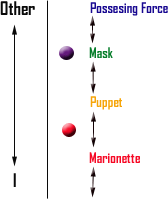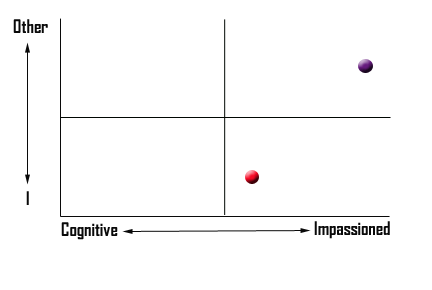So, the second axis I wanted to have a look at is the place that you position yourself to drive your actions in the game. I’m going to talk about this a lot more in future posts, especially about the wording I’ve chosen to describe it: I and Other. For the sake of understanding this introductory post, remember that I am currently working on trying to map the body of play that I once (unsuccessfully) tried to shoehorn into the word immersion; Other could at some point have further application, and will definitely have a more detailed meaning than this, but for the sake of this one post, think of Other as your object in the fiction: your PC, a communal character that you inhabit in the moment, an NPC with which you drive the game as a GM. The I, of course is you as you (though even that will become a little more complicated later on).
You all (except maybe my Great Aunt Gertrude) will be utterly unsurprised to hear me say at this point that the first indicator of where you sit to drive your play is your socket. A person with a primary character socket and no secondary socket is likely going to sit right up at the top of this scale, especially if their goal is Kenotic, and their payoff has an escapist bent.
Likewise, a person who has, say, a primary system socket, a secondary social socket, and a tertiary story socket might never actually make their contributions to the game through a game object, but will instead, contribute directly to the game. I’ve heard some actual play recordings where the players involved never actually inhabited a character object all. Characters, PC or NPCs were never referred to in the first person, and never had an actual voice in play. Even if the character spoke and was not just paraphrased, the player narrated the speech as if it were dialogue in a novel, rather than a character to inhabit.
On the runway from the I to the Other, there are lots of ways to funnel participation through the character as a game object. I’m going to run some of them down for you using the best analogies I have at my disposal. I am peripherally aware that they are similar to some terms already in use in immersion theory. I want to be clear that I’m not at all trying to adopt those terms and their associated meanings (or baggage). Remember that I don’t read rpg.net or the Forge and I’m not a big forum girl. As such, please do your best when you read on to disassociate what you have been taught I might mean and to concentrate on reading them as simple analogies:
As a marionette, where the player does not inhabit the object, but dances it through the fiction with a directed will, there is a distinct emotional and sensory distance between the player and the character. The two share nothing; the marionette is nothing more than a tool with good aesthetic value.
As a puppet, the player inhabits the object only partially, all decisions are unmitigated by the puppet and are made for the direct, unencumbered benefit of the player or the story or something external to the character object (even if that benefit is the player’s sense of the character’s continuity in the story). The player has some amount of emotional investment in the character object and may have a very detailed blueprint of the puppet but is not influenced by the character object directly. Influence on the game is equally (qualitatively and quantitatively) made via the character object and directly without it.
As a mask, the player maintains a distinct identity within the character object, but has established an emotional, often empathic connection with the object and uses it as the primary vehicle to influence the game. The player is influenced and informed by the character object, and the character object is willfully given a measure of transformative power over the player as a goal of play. The player can take intentional action in the game that is uninfluenced by the character object, but optimally will do so only through the funnel of the character.
As a possessing force, the player abandons a personal identity and surrenders to the character object as a goal of play in order to directly, experience the full subjective reality of the character. The more intensely this is done, the less able the player is take any self-directed action as it does not originate from the (the player’s matrix) of the character’s subjective reality. This is all the way up the Other scale.

Once again, the purple dot is me (my trended behaviour, mind not an absolute that doesn’t exist). The empathic connection to character object is critical to my goal and my payoff, because it is in the ability to feel the emotionality of my character object’s response to the story that my impassioned engagement is fueled and the cathartic response is won. However, it is just as important to me to not then extend to allow the character to be a possessing force because to create really effective cathartic situations and get my Epicaric Virago on, I must have the freedom to manipulate the character and drive her towards badness and strife.Brand is the red dot again. He doesn’t need to be up close and personal with any particular character object in order to get his groove on. In fact, having to live within the confines of a character can sometimes hold him back from getting at his payoff. The character is a very rich source of story bits and momentum tools that make the story hot, but they are not usually gratifying to him in and of themselves.Also it’s worth noting that as a GM, Brand interacts with the Other as if it were a marionette, while as a player, he leans closer to being a puppeteer. I have a similar shift, though not as pronounced: As a player I solidly mask the Other, while as a GM I interact with the Other as both mask and puppet.
So, you can affect the game directly as your self, or you can affect the game funneled through an interaction with a character object. These modes of play are determined by the kind of payoff you are looking for, the kind of goal you set to achieve it and most importantly, by the socket that you use to engage with the game. Now that only two of you (of the original three) are still reading, I’d also like leave you hanging by noting, that while I’ve talked about the Other as character object, I do think it might be possible that other kinds of sockets can also become the Other. Setting is a particularly intriguing one when you think about how no-mythers might marionette the setting while deep setting socket folks (Elliot, I’m looking at you here) may well be considered to be possessed by the setting. If you have ideas on this, post them. Somewhere down the line I’ll likely be coming back to this.

